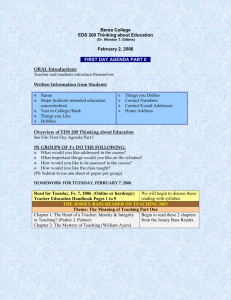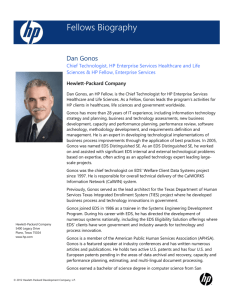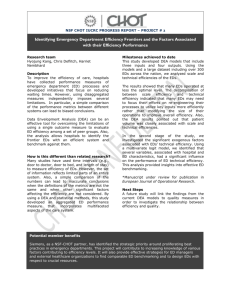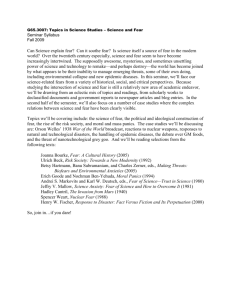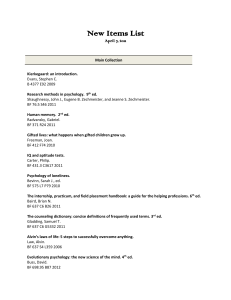Incident Management Team Training 1
advertisement
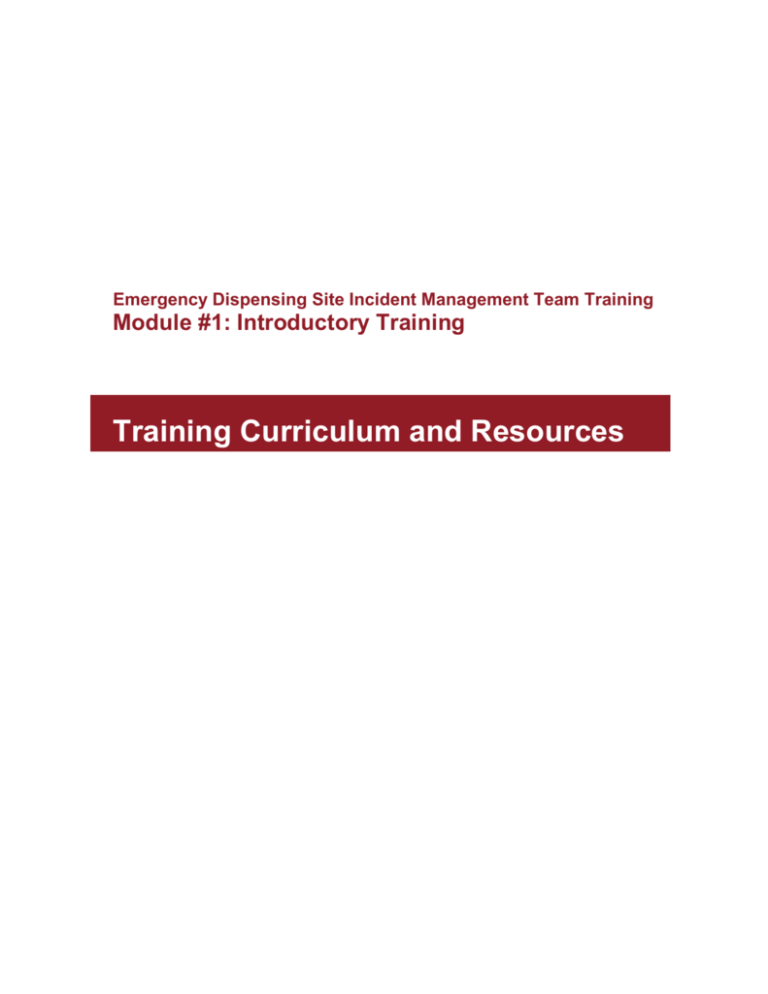
Emergency Dispensing Site Incident Management Team Training Module #1: Introductory Training Training Curriculum and Resources EDS IMT Training - Module #1: Introductory Training Contents Preface ........................................................................................................................... 3 Section 1: Overview ...................................................................................................... 3 Workshop Goal............................................................................................................ 3 Learning Objectives..................................................................................................... 3 Content Outline ........................................................................................................... 4 Learning Methods and Activities.................................................................................. 4 Section 2: Preparation .................................................................................................. 4 Participants (Target Audience) .................................................................................... 5 Participant notification letter ........................................................................................ 5 Breaks ......................................................................................................................... 5 Facilities and Equipment: ............................................................................................ 5 Classroom supplies ..................................................................................................... 5 Print materials needed for training............................................................................... 5 Section 3: Training Basics ........................................................................................... 6 Section 4: Trainer’s guides and facilitation slides ..................................................... 6 Section 5: Evaluation Tools ......................................................................................... 6 Trainer’s Resources ..................................................................................................... 6 Part A Trainer’s Guide - Incident Action Planning ....................................................... 8 Part A – Incident Action Planning Training Packet .................................................... 12 Part B Trainer’s Guide - Transitioning the IAP to EDS Staff ...................................... 20 Part B – Transitioning the IAP to EDS Staff Traning Packet ..................................... 24 Training Evaluation.................................................................................................... 30 2 EDS IMT Training - Module #1: Introductory Training Preface Any mass prophylaxis operation that targets a population at risk, either within or beyond a single jurisdiction’s boundaries, requires coordination to achieve the incident response objectives. This is a challenging endeavor. Procedures, policies, and managerial activities must be coordinated among response organizations. The workforce must be prepared to carry out the operation and have sound knowledge of the plan, policies, and procedures. Personnel must become quickly familiar with requisite forms and necessary equipment. And, critically important to the success of a mass prophylaxis operation, staff and volunteers must be able to work effectively as a team. This training is designed for the Incident Management Team, comprised of the Command and General staff. It is a training activity designed to develop knowledge and skills by drawing upon participant experience and expertise. It employs a training technique where the trainer-to-trainee dynamic is a partnership, the learning setting is casual, and trainees actively identify their learning needs and methods under the guidance of a facilitator. This approach is well suited for an audience of senior managers or supervisors, and subject matter that will evolve as the expertise of the workforce grows. The material presented in the Trainer’s Resources is consistent with the Massachusetts Emergency Planning Region 4b EDS Action Plan Template, version 1.5. This template for a mass prophylaxis action plan and procedures requires very little adjustment to the handouts and trainer’s resources in order to conduct the training. The handout section below identifies items in Version 1.5 that may need to be revised to match your agency’s plan. For questions, please contact: Charles Ishikawa, MSPH, at cishikawa@challiance.org Section 1: Overview This section contains a summary of the Introductory Training for Incident Management Team Personnel on Emergency Dispensing Sites (EDS). Workshop Goal Participants will gain knowledge and skills to plan, organize, and activate a mass prophylaxis operation consistent with the procedures outlined in the EDS Action Plan, version 1.5. Participants will acquire experience in working with the EDS Action Plan, learn from their peers, and collaborate to identify solutions to operational challenges. Learning Objectives 1. Formulate an incident action plan to mitigate a specific public health threat by a mass prophylaxis operation. 2. Identify and propose solutions to policy and procedural issues that affect the quality of the operation 3 EDS IMT Training - Module #1: Introductory Training 3. Articulate policy issues and priorities for mass prophylaxis planning. 4. Articulate knowledge gaps and additional training needs. Content Outline Session 1: Training Kick-off Describe training, scenario/case study, and case study questions focused on Section 1 of the EDS Action Plan. Form teams and distribute Part A Training Packet. Session 2: Part A - Incident Action Planning: Convene small discussion groups to review results of homework. Team members will be randomly assigned to groups. Reconvene all participants for a large group conversation about the results of the homework and any related questions or issues. Distribute Part B Training Packet and describe case study questions focused on Section 2 of the EDS Action Plan. Assign homework to teams. Session 3: Part B - Transitioning the IAP to EDS Staff: Convene small discussion groups to review results of homework. Reconvene all participants for a large group conversation about the results of the homework and any related questions or issues. Learning Methods and Activities This introductory training includes the following types of activities to aid in accomplishing the training goals and objectives: Use of materials from the Emergency Dispensing Site Action Plan, Version 1.5 (or your agency plan), will provide participants with operational steps and planning tools. A public health emergency scenario, presented in Part A Training Packet, will require participants to formulate an incident action plan specific to a mass prophylaxis operation. Case study questions will provide focus for participants as they address issues related to developing an incident action plan and implementing that plan. Homework in teams will allow participants to make a community-specific plan in a limited amount of time. Small group discussions will allow participants to learn from each other by exchanging practices and collective problem solving. Large group discussions will provide participants with an opportunity to expand on knowledge acquired during small group discussions. Small and large group, peer-to-peer discussions will provide the basis for translating the Incident Action Plan (developed by the Incident Management Team) to execution (to be carried out by unit staff). Section 2: Preparation This section details preparation for the Introductory Training for Incident Management Team Personnel. 4 EDS IMT Training - Module #1: Introductory Training Participants (Target Audience) Participants for this training should be persons who may be assigned to any Command and General Command staff position. These positions are: Incident Commander, Public Information Officer, Security Officer, Liaison Officer, Medical Officer, Operations Section Chief, Planning Section Chief, Logistics Section Chief, and Finance and Administration Section Chief. These positions require demonstrated leadership ability and supervisory experience. Previous experience in staffing or planning an emergency mass prophylaxis operation is not a requirement. A participant to trainer ratio of 15:1 is ideal for this training. This ratio will allow for three small groups to form for discussions. This is the maximum number of groups that a trainer can effectively manage during discussions. Participant notification letter If you choose to eliminate the kick-off session, you may distribute the training materials and instructions by mail or email. Breaks Breaks are critical to maintaining participant involvement. We recommend periodic short breaks between small and large group discussions. Facilities and Equipment: □ Projection screen □ LCD projector □ Laptop with Microsoft Office 2002 □ Chairs □ Tables □ The room should have an open layout with few if any fixed pieces of furniture. This will make it easy for participants to arrange their seats for small and large group discussions. Since conversations can become animated during case study discussions, it is helpful to have a room that dampens noise with wall-to-wall carpeting and low ceilings. Classroom supplies □ News print (one per small group) □ Easel (one per small group) □ Markers (one set per group) Print materials needed for training □ EDS Action Plan, Version 1.5 (one per team) □ Part A: Incident Action Planning Training Packet (see Trainer’s Resources) Cover Sheet Table of Contents Training Summary Template 5 EDS IMT Training - Module #1: Introductory Training □ Case and Case Study Questions (Part A) Incident Command Structure Chart – use your agency’s command chart Incident Action Plan – Use the IAP form from your plan Part B: Transitioning the IAP to EDS Staff (see Trainer’s Resources) Cover Sheet Table of Contents Training Summary Template Case and Case Study Questions (Part B) Job Action Sheets for: EDS Director; Clinic Unit Supervisor; Clerical Unit Leader – Use job action sheets for the equivalent positions from your plan Section 3: Training Basics This training uses a non-formal approach to adult education. Participants are given an activity which draws on their own professional experience (e.g., running a flu clinic), and the experience of their peers. In keeping with this approach, the knowledge and mastery of the subject is presumed to be equal among the trainers and participants. Your role as the facilitator is not to have all the answers, but rather to foster collaborative learning and conversation among the participants. Section 4: Trainer’s guides and facilitation slides Guides and facilitation slide sets have been provided at the end of this document to aide trainers in facilitating Parts A and B as outlined. Each guide outlines the training with rough time allocation estimates and crosswalks specific parts of the training to the facilitation slides. In addition, helpful training tips and points where the training can be customized are also indicated. □ Trainer’s guide – Part A □ PowerPoint Facilitation Slide Set Part A □ Trainer’s notes – Part B □ PowerPoint Facilitation Slide Set for Part B Section 5: Evaluation Tools Evaluating your training is essential to determine how successful the training was in achieving the objectives and to identify ways to improve future trainings. A template post-training evaluation has been provided in the trainer’s resources. This survey collects information on the perceived usefulness of the training in thinking through EDS Planning, the degree to which the training activities helped one to learn from others, and collects suggestions for improvement. 6 Trainer’s Resources 7 EDS Incident Management Team Training Module #1: Introductory Training Part A Trainer’s Guide - Incident Action Planning Purpose To develop knowledge and skills to plan, organize, and initiate a mass prophylaxis operation consistent with the procedures outlined in the [EDS Action Plan, version 1.5]. Pre-requisite Modules None Module Time 90 minutes + 15 minute break Learning Objectives At the end of this session/part, participants will be able to: 5. Formulate an incident action plan to mitigate a specific public health threat by a mass prophylaxis operation. 6. Identify and propose solutions to policy and procedural issues that affect the quality of the operation 7. Articulate policy issues and priorities for mass prophylaxis planning. 8. Articulate knowledge gaps and additional training needs. Module Overview Step 1 Activity/ Method Time 5 min Activity Instructions Slides 1 – 4 Review of case study questions and identification of policy and procedural issues Slide 5 40 min Small group discussion 3 15 min Break 40 min 5 5 min Resources Needed Presentation 2 4 Content Slide 6 - 7 Large group discussion Synthesis of small group thought through facilitated conversation Slide 8, Flipchart Wrap-up & Homework #2 Homework #2 instructions Slide 9, Homework #2 Material/Equipment Checklists PowerPoint slides - Discussion#1.ppt Computer w/LCD projector Flipchart & markers Handout – [Name of homework #2] Teaching Guide Slide Number TIPS Teaching Points Make sure that you determine in advance how you would like to group the participants for the small group discussion portion of the training. We suggest grouping the trainees at random to encourage them to meet and work with someone new. Also, determine when you would like people to move in to their small groups. If the room is small and space is tight, you may want the participants to form their small groups before you begin with slide 1. 1 Customization Points Re-title the header slide to reflect the name you use to describe the units that provide emergency mass post-exposure prophylaxis to the population at risk. Insert the name of the appropriate jurisdiction or region name and the date(s) of the training (i.e., Part A and Part B). Part A 2 DISPLAY this slide before you begin the module. Goals & Schedule 3 DISPLAY this slide while reminding the participants about the purpose of this training. Emphasize the collaborative learning that can take place. Ground Rules DISPLAY this slide while discussing the importance of maintaining an environment of respect and open mindedness. Invite participants to elaborate on any of the items, eliminate them, or add to the list. Time Slide Number 4 Teaching Points 5 min Tasks DISPLAY this slide while describing the Tasks that each group needs to complete during the training. Assign one discussion question to each group. Ask that they begin with this question and then discuss a question of their choice. 5 Small Group Discussion Flipchart DISPLAY this slide during the small group discussion portion of the training. EACH small group should have a person who is acting as the recorder for the group by taking notes on the news print/flip chart. At the BEGINNING of the small group discussion section, attend to each group to ensure that the tasks are well understood. Ensure that a recorder has been selected, she/he is performing their duty, and that they are working with their group to record the conversation as opposed to dominating the conversation. TIPS 6 Time DURING the small group discussion portion, you may encounter situations where a single or a couple of group members are dominating the conversation. Your duty as the facilitator is diffuse this situation and engage other members of the group in the conversation. There are many techniques to achieve this. Techniques include: modeling reflective listening; standing behind or next to persons who are having trouble getting in to the conversation; and redirecting questions asked of you by a dominating participant to another group member. Break cont’d from above 40 min 15 min DISPLAY this slide at the end of small group discussion time and while instructing the group on the break. 7 Break Timer DISPLAY this 15 minute counting slide during the break to orient participants to the amount of remaining break time. 8 Large Group Discussion DISPLAY this slide during the large group discussion portion of the training. 40 min Slide Number Tips Teaching Points Time DURING the large group discussion portion, have the reporter from each group stand and share what their group came up with as an answer to their assigned question. Once the reporter is finished, ask the other participants if they have anything to add or emphasize. Strive to generate discussion between and amongst the participants. When the conversation lulls and no one has anything to add, have the next group report on their group’s work. Continue in this fashion until all groups have had an opportunity to report. Time permitting, have groups then report on the answers they came up with to their selected question. Throughout this portion of the training, remain flexible and prepared to flow with the trainee’s interests. Reinforce planning issues that are applicable to any hazard. Draw attention away from issues that are unique to a particular scenario or hazard. 9 Customization Notes Re-title the slide to reflect the name you use to describe the units that provide emergency mass post-exposure prophylaxis to the population at risk. [EDS] Training: Part B DISPLAY this slide while homework packets for the second part of the training are handed out. Walk participants through the content of the packets. Explain what they need to complete before the next part of the training. Emphasize the importance of limiting the amount of time they spend to two hours. 5 min. Emergency Dispensing Site Incident Management Team Module #1: Introductory Training SECTION #1 Part A – Incident Action Planning Training Packet [Insert Jurisdiction Name Here] [Insert date of training here] [Insert Name and contact information of training facilitator here] Training Summary Introductory Training for the IMT [Insert jurisdiction name and/or logo here] Dates: [Dates of training] Goal Participants will gain knowledge and skills to plan, organize, and activate a mass prophylaxis operation consistent with the procedures outlined in the [POD/DVC/EDS] Plan. Participants will acquire experience in working with the [POD/DVC/EDS] Plan, learn from their peers, and collaborate to identify solutions to operational challenges. Objectives 1. Formulate an incident action plan to mitigate a specific public health threat by a mass prophylaxis operation. 2. Identify and propose solutions to policy and procedural issues that affect the quality of the operation 3. Articulate policy issues and priorities for mass prophylaxis planning. 4. Articulate knowledge gaps and additional training [POD/DVC/EDS] needs. Schedule [insert first meeting date here] [Insert date of Part A here] Describe training activity and handout Part A for completion prior to the next meeting. Participants will utilize existing plans and partnerships to complete the homework. Approximately 90 minutes will be spent discussing the individual responses to Part A. Discussion will first take place in sub-regional groups and then a full group debrief will take place. Handout Part B for completion prior to the next meeting. Participants will utilize existing plans and partnerships to complete the homework. [Insert date of Part B here] Approximately 90 minutes will be spent responses to Part B. Discussion will first take place in sub-regional groups and then a full group debrief will take place. A training evaluation will be distributed at the end to collect your thoughts about the training. Materials □ [Participant’s department [POD/DVC/EDS] plan] □ Training Packet, Part A □ Training Packet, Part B Part A – Incident Action Planning Introductory Training for the IMT Please complete the following questions by our next meeting on [Insert date]. We suggest that you spend no more than 4 hours to complete this homework; as if you were doing this in real-time and have a half day to lay out your plans. Use your department’s [POD/DVC/EDS] Plan and relationships with community emergency response partners to work out your answers to these questions. Remember, this is for training purposes only. There are no right or wrong answers. 1. Given this scenario, how might your city/town organize the management of an [POD/DVC/EDS] operation to meet the response objectives? Please fill in the incident command chart provided. 2. Please use the Incident Response Objective Sheet enclosed to answer the following questions about Week 1 of operations: a. Who are the essential service personnel in the community? b. How will you define “family” for the essential service personnel? c. How will you validate that a person is a “family member” of an essential service worker? d. Where will you locate the [POD/DVC/EDS] (s) for your community? e. How will you move people through your [POD/DVC/EDS]? Please sketch your [POD/DVC/EDS] flow design in the space provided. 3. Please use the Incident Response Objective Sheet enclosed to answer the following about weeks 3-4 of operation: a. How many people do you expect to serve in your [POD/DVC/EDS] (s) per week? b. Assuming no further guidance from MDPH regarding priority groups, will you set priority groups? If so, what are they? c. Where will you locate the [POD/DVC/EDS] (s) in your community? d. How will you move people through your [POD/DVC/EDS]? Please sketch your [POD/DVC/EDS] flow design in the space provided. 4. Please answer the following questions about Special Populations: a. In this scenario, what are the special population groups in your community? b. What community assets would you utilize to reach these groups? 5. How will you inform essential service personnel and residents about the city/town’s plan on how they will receive vaccine? 6. Briefly describe how you will identify resource requirements to sustain the [POD/DVC/EDS] operation in this scenario? EDS Operation: Incident Command Structure Worksheet [POD/DVC/EDS] Incident Action Plan Date: Week 1 [POD/DVC/EDS] Location Time: TBD by LPHA TDB by LPHA Disease causing agent: Novel, highly pathogenic strain of influenza Population at risk (n) = of resident population Notes on risk exposure Standard risk exposures for influenza Target population service rate (n/week) = TBD by LPHA Target [POD/DVC/EDS] flow rate (n/day) = TBD by LPHA Description of service Provide vaccine to the disease causing agent to essential service personnel in 7 days Medications/Vaccines Influenza vaccine Standards of Care TBD by LPHA Client Flow Diagram/Clinic Layout TBD by LPHA Operations Section Chief Name (printed): Signature: Incident Commander Name Printed: Signature: [POD/DVC/EDS] Incident Action Plan Date: Week 2 - 4 [POD/DVC/EDS] Location Time: TBD by LPHA TDB by LPHA Disease causing agent: Novel, highly pathogenic strain of influenza Population at risk (n) = of resident population Notes on risk exposure Standard risk exposures for influenza Target population service rate (n/week) = TBD by LPHA Target [POD/DVC/EDS] flow rate (n/day) = TBD by LPHA Description of service Provide vaccine to the disease causing agent to remaining resident population Medications/Vaccines Influenza vaccine Standards of Care TBD by LPHA Client Flow Diagram/Clinic Layout TBD by LPHA Operations Section Chief Name (printed): Signature: Incident Commander Name Printed: Signature: EDS Incident Management Team Training, Module #1: Introductory Training Part B Trainer’s Guide - Transitioning the IAP to EDS Staff Purpose To develop knowledge and skills to plan, organize, and initiate a mass prophylaxis operation consistent with the procedures outlined in the [EDS Action Plan, version 1.5]. Pre-requisite Modules None Module Time 90 minutes + 15 minute break Learning Objectives At the end of this session/part, participants will be able to: 1. Formulate an incident action plan to mitigate a specific public health threat by a mass prophylaxis operation. 2. Identify and propose solutions to policy and procedural issues that affect the quality of the operation 3. Articulate policy issues and priorities for mass prophylaxis planning. 4. Articulate knowledge gaps and additional training needs. Overview Step 1 Activity/ Method Time 5 min Activity Instructions Slides 1 – 4 Review of case study questions and identification of policy and procedural issues Slide 5 40 min Small group discussion 3 15 min Break 40 min 5 5 min Resources Needed Presentation 2 4 Content Slide 6 – 7 Large group discussion Synthesis of small group thought through facilitated conversation Slide 9, Flipchart Training Evaluation Administer survey tool Slide 10, Training evaluation survey Material/Equipment Checklists PowerPoint slides - Discussion#2.ppt Computer w/LCD projector Flipchart & markers Training Evaluation Survey Teaching Guide Slide Number TIPS Teaching Points Time Make sure to determine in advance how the participants will be grouped for the small group discussion portion of the training. We suggest grouping the trainees at random to encourage them to meet and work with someone new. Also, determine when you would like people to move in to their small groups. If the room is small and space is tight, you may want the participants to form their small groups before you begin with slide 1. Customization Points 1 Re-title the header slide to reflect the name used to describe the units that provide emergency mass post-exposure prophylaxis to the population at risk. Insert the name of the appropriate jurisdiction or region name and the date(s) of the training. Part B DISPLAY this slide before you begin the module. Customization Point 2 The contents of this slide should reflect the details of the scenario used in the homework. The Scenario DISPLAY this slide as you recap the scenario within which the training has been conducted. Goals & Schedule 3 DISPLAY this slide while reminding the participants about the purpose of this training. Emphasize the collaborative learning that can take place. 5 min Slide Number Teaching Points 4 Tasks for Small Group Discussion 5 DISPLAY this slide while describing the Tasks that each group needs to complete during the training. Assign one discussion question from homework #1 to each group. Ask that they begin with this question and then discuss a question of their choice. Small Group Discussion Time DISPLAY this slide during the small group discussion portion of the training. Flipchart EACH small group should have a person who is acting as the recorder for the group by taking notes on the news print/flip chart. At the BEGINNING of the small group discussion section, attend to each group to ensure that the tasks are well understood. Ensure that a recorder has been selected, she/he is performing their duty, and that they are working with their group to record the conversation as opposed to dominating the conversation. TIPS 40 min DURING the small group discussion portion, you may encounter situations where a single or a couple of group members are dominating the conversation. Your duty as the facilitator is diffuse this situation and engage other members of the group in the conversation. There are many techniques to achieve this. Techniques include: modeling reflective listening; standing behind or next to persons who are having trouble getting in to the conversation; and redirecting questions asked of you by a dominating participant to another group member. 6 Break DISPLAY this slide at the end of small group discussion time and while instructing the group on the break. 15 min 7 Break Timer DISPLAY this 15 minute counting slide during the break to orient participants to the amount of remaining break time. Slide Number Tips 8 Teaching Points Time DURING the large group discussion portion, have the reporter from each group stand and share what their group came up with as an answer to their assigned question. Once the reporter is finished, ask the other participants if they have anything to add or emphasize. Strive to generate discussion between and amongst the participants. When the conversation lulls and no one has anything to add, have the next group report on their group’s work. Continue in this fashion until all groups have had an opportunity to report. Time permitting, have groups then report on the answers they came up with to their selected question. Throughout this portion of the training, remain flexible and prepared to flow with the trainee’s interests. Reinforce planning issues that are applicable to any hazard. Draw attention away from issues that are unique to a particular scenario or hazard Large Group Discussion: Question 1 DISPLAY this slide during the large group discussion portion of the training when the group reporting on the first question is speaking. 40 min Incident Command Chart 9 10 11 12 13 DISPLAY this slide to reference the command chart while the trainees discuss issues related to the first question. Large Group Discussion: Question 2 DISPLAY this slide during the large group discussion portion of the training when the group reporting on the first question is speaking. Large Group Discussion: Question 3 DISPLAY this slide during the large group discussion portion of the training when the group reporting on the first question is speaking. Large Group Discussion: Question 4 DISPLAY this slide during the large group discussion portion of the training when the group reporting on the first question is speaking. Training Evaluation DISPLAY this slide while participants are completing the training evaluation. 5 min Emergency Dispensing Site Incident Management Team Module #1: Introductory Training Part B – Transitioning the IAP to EDS Staff Training Materials [Insert Jurisdiction Name Here] [Insert date of training here] [Insert Name and contact information of training facilitator here] Part B – Transitioning the IAP to EDS Staff Introductory Training for the IMT Please complete the following questions by our next meeting on [Insert date]. We suggest that you spend no more than 4 hours to complete this homework; as if you were doing this in real-time and have a half day to lay out your plans. Use your department’s [POD/DVC/EDS] Plan and relationships with community emergency response partners to work out your answers to these questions. Remember, this is for training purposes only. There are no right or wrong answers. 7. How will you organize and manage the [POD/DVC/EDS] site that you laid out in Part 1 of this exercise? Please modify the command chart provided with this packet to indicate how you would staff the site. 8. Using the Job Action Sheets provided as guidance, please outline 3-5 things that you would include in training for the: [POD/DVC/EDS] Director; Clinical Unit Supervisor; and Clerical Unit Leader? 9. What Memoranda of Understanding would you need to have in place with vendors or service providers to support operations of your [POD/DVC/EDS] site? 10. How might your city or town determine when to end the [POD/DVC/EDS] operation in this scenario? Who will lead the recovery effort and what will that entail? EDS Operation: Incident Command Structure Worksheet Emergency Dispensing Site Director Supervisor: Operations Section Chief Mission: The EDS Director is responsible for overall management of EDS operations with support from the Operations, Logistics, and Planning Sections of the Command and General Staff. The EDS Director has executive responsibility for directing all aspects of deployment, operation and maintenance, and deactivation of the EDS. Activation (Phase I & II) □ □ □ □ □ Meet with Operations Section Chief. Receive the following information: Site location Response objectives for the EDS EDS design EDS organization chart Job action sheets Guidelines regarding the frequency of updates to Operations Section Chief The media policy Report to EDS location and identify immediate resource needs Appoint and orient EDS staff Set time that stations will be ready for pre-opening review Review all EDS stations prior to opening and make necessary changes for smooth operation Operation (Phase III) □ □ □ □ □ □ □ Oversee training and orientation of staff members with delegated roles Identify leaders in each area to provide focus and coaching Assess staff and supplies at the start and end of each shift Communicate additional staff and supply needs to the Operations Section Chief Monitor performance and make necessary changes to ensure smooth operation of the EDS Submit shift reports to Operations Section Chief Refer all media inquiries to the Public Information Officer Deactivation (Phase IV) □ □ □ □ Oversee the closing and clean-up of the site Oversee the appropriate return of supplies Ensure the completion and collection of all required documentation Participate in recovery activities as directed by the Operations Section Chief (Rev. 3/8/2016) Clerical Unit Leader Supervisor: EDS Director Mission: To ensure that clerical support staff are familiar with necessary forms, ensure the steady flow of client information throughout the EDS, and oversee the security of all client information. Activation (Phase I & II) □ □ □ □ □ □ □ □ Report to the EDS Director Identify immediate resource needs Assign staff to workstations Orient staff to assigned roles Oversee set-up of clerical unit workstations Identify additional staffing and supply needs and communicate to Logistics Officer Appoint leaders in each area Ensure coordination with Clinical Unit areas Operation (Phase III) □ □ □ □ □ □ Oversee training and orientation of replacement clerical unit staff Assess staff and supplies at the end of each shift and identify additional needs Communicate additional staff and supply needs to Logistics Officer Monitor the flow of client information Assess Clerical Unit performance and make necessary changes Provide service reports to EDS Director as requested Deactivation (Phase IV) □ □ □ □ □ □ □ Close out logs when authorized by the EDS Director Oversee closing of Clerical Unit stations Oversee clean-up of Clerical Unit stations Return supplies to Logistics Officer Complete all required documentation Submit all required documentation to the EDS Director Participate in recovery activities as directed by the EDS Director (Rev. 3/8/2016) Clinical Unit Supervisor Supervisor: EDS Director Mission: To ensure that clinical staff are familiar with their responsibilities and the clients are treated professionally throughout the EDS. Activation (Phase I & II) □ □ □ □ □ □ □ Report to EDS Director Identify immediate resource needs Appoint and orient staff to clinical roles Oversee the set up clinical unit workstations Identify additional staffing and supply needs and communicate to Logistics Officer Appoint leaders in each area Ensure coordination with clerical unit workstations □ □ □ □ □ □ Oversee training and orientation of staff Ensure that required supplies are available to clinical unit staff Assess staff and supplies at the end of each shift Communicate additional staff and supply needs to the Logistics Officer Monitor client flow through the EDS Assess Clinical Unit performance and make changes as necessary □ □ □ □ □ □ □ Close out logs when authorized by the EDS Director Oversee closing and clean-up of Clinical Unit stations Return supplies to Logistics Officer Ensure safe disposal of medical and biohazard waste in coordination with Logistics Officer Complete all required documentation Submit all required documentation to the EDS Director Participate in recovery activities as directed by the EDS Director Operation (Phase III) Deactivation (Phase IV) (Rev. 3/8/2016) Incident Management Team Training Module #1: Introductory Training for the IMT Post-Training Evaluation We would like to take a few minutes more of your time to get some feedback on the training. The information you provide will be used to help us improve the training program. We are sincerely open to positive and critical feedback. Your honesty is greatly appreciated. 1. Did you participate in both Emergency Dispensing Site (EDS) training sessions, Part A and B? No Yes, only one has been held Yes, one out of two Yes, both 2. How much of the homework were you able to complete before the meeting(s)? None of it Some of it All of it 3. Did you work with anyone else to complete the homework? No Yes, then who? 4. How helpful was the homework in helping you think through the organizational structure and resources that would be needed to set up an EDS in your community? 1 Not Useful 2 3 Somewhat Useful 4 4a. What did you find most useful about the training? Thank you 5 Very Useful Incident Management Team Training Module #1: Introductory Training for the IMT 4b. What did you find least useful about the training? 5. Are there any topics or issues you think are missing from this training? No Yes. If yes, tell us what topics should be included: 6. Do you have any additional recommendations for improvement or other comments regarding the training? 7. What additional training or experience would increase your ability to plan and command an [EDS] operation? Thank you
